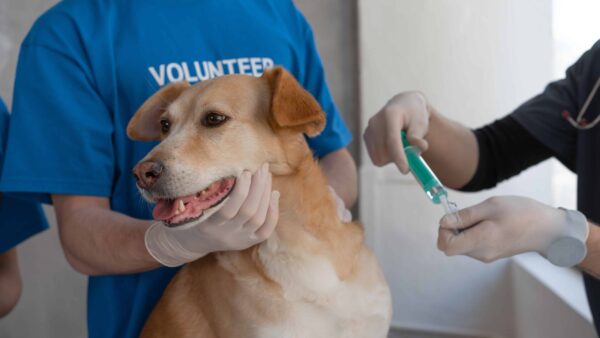Dogs can indeed feel sick after a rabies shot. The dog may have an allergic reaction to the rabies vaccine.
This can be uncomfortable and even painful for the dog. It is important to know that this reaction will not happen every time a dog gets a rabies shot.
Some people might also think that dogs can feel sick after a rabies shot because they are not being vaccinated enough.
In reality, this is not the case since it is required by law for all dogs to be vaccinated against rabies in the United States.
The rabies vaccine is a series of shots given to dogs to prevent them from getting the rabies virus.
The question is whether or not the dog can feel sick after getting a rabies shot. The answer is that it depends on the dog’s age and immune system.
If we look at puppies, for example, they need several doses of vaccination before they become immune to the virus. They will also experience a fever and other symptoms as their body reacts to the vaccine.
This is because their immune system has not yet been fully developed and cannot protect them against certain diseases like rabies.
What You Need To Know About Rabies Vaccination For Your Dog

Rabies is a deadly virus transmitted through an infected animal’s saliva. Rabies can affect any mammal, but it’s most common in dogs, cats, and wild animals.
Many people believe that rabies vaccination for dogs is unnecessary because they don’t live in an area with a high risk of exposure to rabies. However, this misconception could lead to severe consequences.
Rabies vaccination for your dog should be done every year. It will be necessary if you live in a country with endemic rabies or are traveling to one.
Rabies is a viral disease affecting mammals’ central nervous systems, including humans. It is a zoonotic disease that can be transmitted to humans by a bite from an infected animal.
The rabies vaccination for your dog consists of three shots given over the course of two weeks.
The first shot will be given at the veterinarian’s office or by your local animal control officer, and the second shot will be administered at home. The third shot should be administered two to four weeks after the second one. It can also be given by your veterinarian or animal control officer.
Dogs must be vaccinated against rabies as soon as they are old enough to have their first vaccinations.
Symptoms of Rabies in Dogs
Rabies is a viral disease transmitted through an infected animal’s saliva. The virus affects the central nervous system and causes various symptoms in animals.
Rabies is a virus that affects the central nervous system and can spread to other animals and humans.
The rabies virus enters through the mouth, nose, or eyes and travels to the brain. The symptoms of rabies in dogs are similar to those of many other diseases, so it is important to vaccinate your dog against rabies if they are at risk.
These symptoms include fever, agitation, weakness, lack of appetite, and seizures.
These symptoms can also be caused by other diseases such as distemper or cancer so it is important for your vet to rule out these possibilities before diagnosing your dog with rabies.
The following are the most common symptoms of rabies in dogs:
– Agitation, confusion, or aggressiveness
– Excessive drooling, difficulty swallowing, or paralysis
– Unusual excitement or activity periods followed by lethargy or depression
– Difficulty breathing and swallowing
– Paralysis of facial muscles and limbs
Rabies is a deadly disease that can be transmitted to humans. It is caused by a virus that infects the central nervous system and can be prevented by proper vaccinations.
Rabies is usually transmitted through saliva, an infected bite, or a scratch. Still, it can also be transmitted by other means, such as contact with infected saliva on food or water bowls, pet toys, and bedding.
The first symptoms of rabies in dogs may include fever, seizures, and weakness.
Later symptoms may include paralysis, difficulty swallowing and breathing, drooling, and hydrophobia (fear of water).
If left untreated, rabies will lead to death within days or weeks.
Treatment for Rabid Animals and Humans
Rabies is a virus that infects the nervous system and is transmitted to humans through bites from infected animals.
The virus can be transmitted to humans by contact with saliva from an infected animal.
The rabies vaccine is given in two doses, usually one month apart. It is effective in preventing rabies if given before symptoms appear.
The treatment for rabid animals and humans includes a series of injections administered over a period of days or weeks, depending on the severity of the infection.
The rabies vaccine is given to people who have been exposed to rabies. It can also be given to secondary contacts of persons who have been exposed. The vaccine is not 100% effective, but it greatly reduces the risk of developing rabies.
There are two types of rabies vaccines: one for humans and one for animals. The human vaccine consists of four doses given over a period of 28 days, while the animal vaccine consists of three doses given over a period of 21 days.
The treatment for rabies in humans is called post-exposure prophylaxis (PEP).
This treatment consists of a series of vaccinations over the course of two weeks.
The virus can infect many other mammals, including cats, bats, monkeys, raccoons, skunks, and foxes.
Rabies is a fatal disease that affects the central nervous system. It can be prevented through vaccination.







Leave a comment